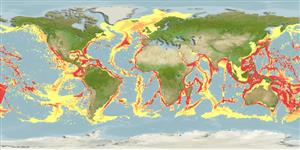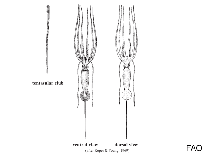Joubiniteuthis portieri (Joubin, 1916)
Joubin's squid| Native range | All suitable habitat | Point map | Year 2050 |

|
| This map was computer-generated and has not yet been reviewed. |
| Joubiniteuthis portieri AquaMaps Data sources: GBIF OBIS |
Upload your photos
Google image | No image available for this species;
drawing shows typical species in Joubiniteuthidae.
Google image | No image available for this species;
drawing shows typical species in Joubiniteuthidae.
Classification / Names Common names | Synonyms | CoL | ITIS | WoRMS
Cephalopoda | Teuthida | Joubiniteuthidae
Environment: milieu / climate zone / depth range / distribution range Ecology
Pelagic; depth range 1 - 3500 m (Ref. 97142). Tropical
Distribution Countries | FAO areas | Ecosystems | Occurrences | Introductions
Circumglobal. Tropical, subtropical, and temperate..
Length at first maturity / Size / Weight / Age
Maturity: Lm ? range ? - ? cm Max length : 10.5 cm ML male/unsexed; (Ref. 104052)
Tail length an additional 15.5 cm. Depth range based on depths of capture in open nets; 1 individual captured at 3,500 m (Ref. 97142). Minimum depth from Ref. 110525. Males are fully mature at 10.5 cm mantle length; females clearly developing but immature at 8.5 cm mantle length, with paired nidamental glands. Depths of capture in open nets range from 300 to 500 m at night (1 at 3,500 m) and 800 to 2,500 m during daytime: this clearly is a meso- to bathypelagic species. Specimens are reported as prey of lancetfish, blue shark and sperm whale (Ref. 97142).
Life cycle and mating behavior Maturity | Reproduction | Spawning | Eggs | Fecundity | Larvae
Members of the class Cephalopoda are gonochoric. Male and female adults usually die shortly after spawning and brooding, respectively. Mating behavior: Males perform various displays to attract potential females for copulation. During copulation, male grasp the female and inserts the hectocotylus into the female's mantle cavity where fertilization usually occurs. Life cycle: Embryos hatch into planktonic stage and live for some time before they grow larger and take up a benthic existence as adults.
Main reference
References | Coordinator | Collaborators
Turgeon, D.D., J.F. Quinn Jr., A.E. Bogan, E.V. Coan, F.G. Hochberg, W.G. Lyons, P.M. Mikkelsen, R.J. Neves, C.F.E. Roper, G. Rosenberg, B. Roth, A. Scheltema, F.G. Thompson, M. Vecchione and J.D. Willams. 1998. (Ref. 1667)
IUCN Red List Status (Ref. 130435)
Least Concern (LC) ; Date assessed: 05 May 2010
CITES status (Ref. 108899)
Not Evaluated
CMS (Ref. 116361)
Not Evaluated
Threat to humans
Human uses
| FishSource |
Tools
More information
Internet sources
BHL | BOLD Systems | CISTI | DiscoverLife | FAO(Publication : search) | Fishipedia | GenBank (genome, nucleotide) | GloBI | Gomexsi | Google Books | Google Scholar | Google | PubMed | Tree of Life | Wikipedia (Go, Search) | Zoological Record
Estimates based on models
Preferred temperature
(Ref. 115969): 3.1 - 10.2, mean 5.2 (based on 2613 cells).



